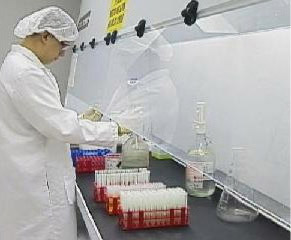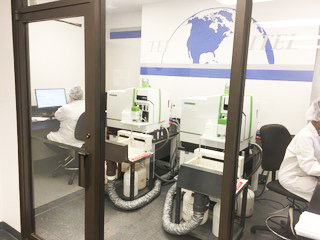Quality Assurance/Quality Control (QA/QC)
Quality Assurance (QA) - A system of recording and evaluating past history, sources and quality of all laboratory services, calibration and performance of equipment used, to ensure a consistently high quality of analytical results.
Quality Control (QC) - A comprehensive set of procedures established in order to control the constant quality of analytical results, by continuous daily analysis of check control samples of known composition, and daily calibration of all apparatus used in analysis.

Trace Elements is very committed to the profession, to our clients and to our employees as witnessed by our
increasing investment in highly trained personnel, on-going operations and in some of the finest modern technology
available in the world. TEI is a licensed and certified clinical laboratory that undergoes regular inspections with
the Clinical Laboratory Division of the Department of Health and Human Services, HCFA. TEI uses ICP-Mass Spectrometry,
the most modern and expensive analytical technique to be applied to routine elemental analysis.
TEI performs all testing in a trace element laboratory clean room environment, utilizes the latest microwave
temperature-controlled digestion technique and has a highly skilled and professional analytical/support staff.
Further, each patient result from TEI is based upon an hourly National Institute of Standards and Technology (NIST)
traceable standard curve, a rigorous quality control validation for every 24 specimens and is compared to a
representative reference range derived from the like analysis of an international collection of normal and "healthy"
subjects. TEI also performs routine spiked sample recoveries, daily split specimen analysis and voluntarily
participates in various interlaboratory test comparison (TC) surveys. Additionally, TEI like many laboratories,
participates in an on-going Quality Assurance/Quality Control program and adheres to CLIA guidelines for precision,
reliability and overall good laboratory practices. Needless to say, you can be assured that we stand behind our
analytical data.
Trace Elements utilizes state-of-the-art ICP-Mass Spectrometry (NexION® models) for all trace element
determinations. These multiple systems are capable of easily handling a high volume of specimens in
applications such as HTMA where limits of detection requirements are in the part-per-million (ppm) and
low part-per-billion (ppb) range.
TEI uses the most advanced high-volume and uniform temperature-controlled microwave digestion (CEM Mars 6) technique.
Microwave digestion is the method of choice for speed, reduced contamination, complete digestions, and retention of analytes
to insure precise results. Trace Elements laboratory is equipped with a trace element class clean room utilizing
HEPA filtration systems. The clean room ensures that air quality and temperatures are isolated in order to protect equipment
and processed specimens from potential contamination. High sensitivity balances used by the laboratory for calibration/QC
check standards and specimen weighing are calibrated with weight sets traceable to NIST. All stock standards used for daily
calibration and Quality Control are prepared by a leading ISO 9001 certified laboratory. In addition, all standard material
is sourced from NIST standard reference material. Further, the laboratory uses 18 megohm double-deionized water, sterile
polypropylene wet-digestion and sampling test tubes, acid-leached, triple-rinsed miscellaneous glassware and plasticware.
All glassware when used is Class A.
Trace Elements conducts daily, weekly and monthly QA/QC studies to confirm and validate all aspects of test
methodology, including precision, accuracy and verifiable detection limits. Further, the laboratory is
continuously evaluating the different aspects of daily laboratory performance, such as; reagents, QC
reference materials, split specimen analysis, double-blind samples, spiked samples, calibration-verification
studies and routine daily monitoring of patient data trends, before, during and after each daily analytical run.
This attention to detail assures that our clients are receiving data obtained by the highest standards.
Additional audits involve personnel training, laboratory reporting, safety issues, customer service, etc...
Laboratory management also utilizes a comprehensive state-of-the art proprietary data management program
that features automated quality control (AQC) software to assist the chief technologist and laboratory director
in validating all QC test results and individual specimen test results prior to release for eventual report
processing. Trace Elements successfully participates in an on-going proficiency testing program with Le Centre
de Toxicologie du Quebec, which offers urine, blood and hair tissue elemental testing involving clinical
laboratories that utilize high resolution instrumentation in North America and Europe. Also participating in
various other interlaboratory test comparison studies, Trace Elements is committed to providing the clinician
with timely, precise and reliable test data.
